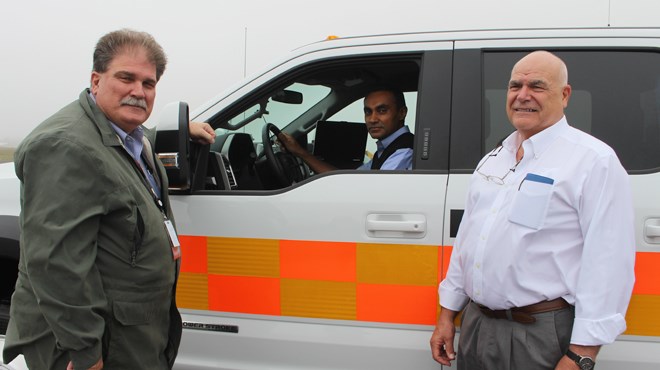Greater Sudbury Airport kicked off a collaborative project on Oct. 1 that will support the airport industry in its efforts to improve the safety of air travel.
Working in collaboration with Team Eagle and Laurentian University's Centre for Research in Occupational Health and Safety (CROSH), the airport unveiled the Braking Availability Tester (BAT), a piece of technology that measures and reports the effects of things like rain, snow and slush on aircraft anti-skid braking.
The BAT system is a pair of aircraft braking systems mounted to a pickup truck; that equipment is all hooked up to a computer system and is able to emulate an aircraft's in-situation anti-skid braking system in order to provide data that indicates the expected aircraft braking deceleration in a variety of conditions.
This data is provided to pilots and gives them a more scientific break down of what distance will be needed to safely bring an aircraft to a stop.
"From our perspective safety is our No. 1 concern, anything that we can do to enhance our safety of the aircraft landing and the passengers on board is our primary concern," said Todd Tripp, CEO Greater Sudbury Airport.
"To help (Team Eagle) and aviation in general, we've partnered with Steve (McKeown) and Laurentian to put this into final testing and let's get this thing out there and into service. I think that the airport here we have the opportunity here in Sudbury with other organizations like NORCAT that are so innovative in their thinking that we have to join them with that. We have to be ready to be innovative, bring in new technology and welcome new opportunities into Sudbury. If it brings in employment, that's even better, but if we can make ourselves a much better and safer airport that's our number one goal.
"It's exciting news for us at the airport, we're always looking for new ways to improve our technology right across not only Canada, but across the world."
"This technology has been around for some time in the testing mode, but we're going to work with Team Eagle to bring it over the top and make it usable across the world."
Team Eagle developed a prototype of the technology back in 2007 and have been using and testing the technology for nearly seven years. The first commercial BAT unit was sold to Montreal's airport.
"This is the first time it's been in Northern Ontario and the first time it's been out of the Ottawa and Peterborough airports," said Steve McKeown, CEO of Team Eagle.
"With this device here it's an aircraft anti-skid system mounted into the vehicle and a landing gear that goes down and has the same contact pressure between the runway as an aircraft and that provides an actual aircraft wheel braking coefficient which can be translated, so we can actually tell pilots in their lookup charts how fast they're going to decelerate."
In short, the device can calculate the distance it will take a pilot to bring a plane to a complete stop, taking into account runway and environmental conditions.
The vehicle is equipped with an aircraft wheel that is under the vehicle, and is actuated with 2,500 pounds of downforce by a hydraulic compressor system inside of the truck.
"That's to simulate an aircraft's weight," said Dan Dos Reis, engineer with Team Eagle. "We use an aircraft braking algorithm to try and simulate what the pulsating impulse would be on the brakes for an aircraft."
There is also an exterior wheel on the outside of the truck that is constantly measuring the friction of the runway and the impact that it will have on deceleration.
"The pilot would be able to punch that information into his computer and it'll spit out a landing distance for him," said Dos Reis. "It's most important in snowy conditions where a wheel that's braking all the time might skid through the snow, but an aircraft tire when it's just pulsating might not skid, and you'll get hydroplaning."
Team Eagle has provided the tech, the Greater Sudbury Airport is providing the testing area and the crew, while CROSH will be responsible for ensuring that the technology is as user-friendly as possible during the eight weeks that they will be evaluationg the BAT device with actual users from the Greater Sudbury Airport.
"We're going to be looking at the usability of the system, not the mechanical side, but more so how the operator interacts with the computer and the user interface," said Laurentian University professor Dr. Ratvinder Grewal.
"So the information that needs to be entered into the computer, can that be done in an easy and intuitive manner. The information that's outputted from the user interface, can that be read so there's no confusion or ambiguity. We'll be offering suggestions on how that can be improved so that when any training does need to happen for subsequent operators, rather than having the engineers come on site, the airport can train their people. We'll be putting together a user manual on how subsequent operators can be trained."
Taking effect in November 2020, Transport Canda will implement the International Civil Aviation Organization (ICAO) Global Reporting Format that will require airports to comply with stringent details when assessing and reporting runway surface conditions.
With the acquisition of this technology, the Greater Sudbury Airport said it has taken on a leadership role in advancing safety and efficiency in runway surface condition assessment.
